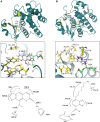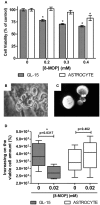8-Methoxypsoralen is a competitive inhibitor of glutathione S-transferase P1-1
- PMID: 25324722
- PMCID: PMC4179718
- DOI: 10.3389/fncel.2014.00308
8-Methoxypsoralen is a competitive inhibitor of glutathione S-transferase P1-1
Abstract
The blood-brain barrier (BBB) is known to protect healthy brain cells from potentially dangerous chemical agents, but there are many evidences supporting the idea that this protective action is extended to tumor cells. Since the process of angiogenesis in brain tumors leads to BBB breakdown, biochemical characteristics of the BBB seem to be more relevant than physical barriers to protect tumor cells from chemotherapy. In fact, a number of resistance related factors were already demonstrated to be component of both BBB and tumor cells. The enzyme glutathione S-transferases (GST) detoxify electrophilic xenobiotics and endogenous secondary metabolites formed during oxidative stress. A role has been attributed to GST in the resistance of cancer cells to chemotherapeutic agents. This study characterized 8-methoxypsoralen (8-MOP) as a human GST P1-1 (hGST P1-1) inhibitor. To identify and characterize the potential inhibitory activity of 8-MOP, we studied the enzyme kinetics of the conjugation of 1-chloro-2,4-dinitrobenzene (CDNB) with GSH catalyzed by hGST P1-1. We report here that 8-MOP competitively inhibited hGST P1-1 relative to CDNB, but there was an uncompetitive inhibition relative to GSH. Chromatographic analyses suggest that 8-MOP is not a substrate. Molecular docking simulations suggest that 8-MOP binds to the active site, but its position prevents the GSH conjugation. Thus, we conclude that 8-MOP is a promising prototype for new GST inhibitors pharmacologically useful in the treatment of neurodegenerative disorders and the resistance of cancer to chemotherapy.
Keywords: 8-MOP; GST; glioblastoma.
Figures






References
LinkOut - more resources
Full Text Sources
Other Literature Sources
Research Materials

